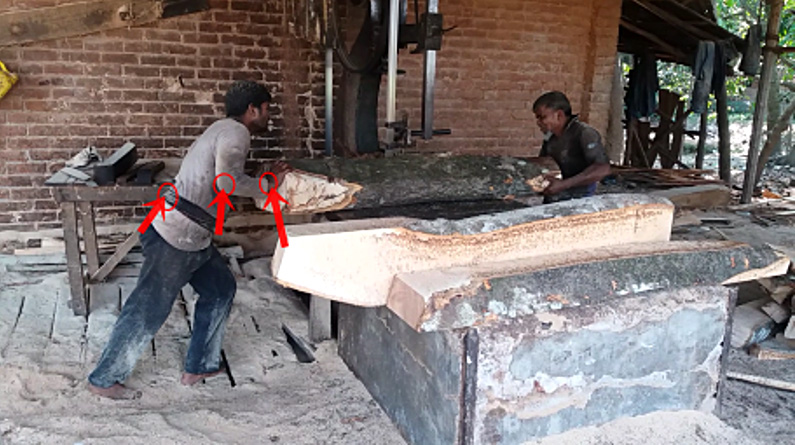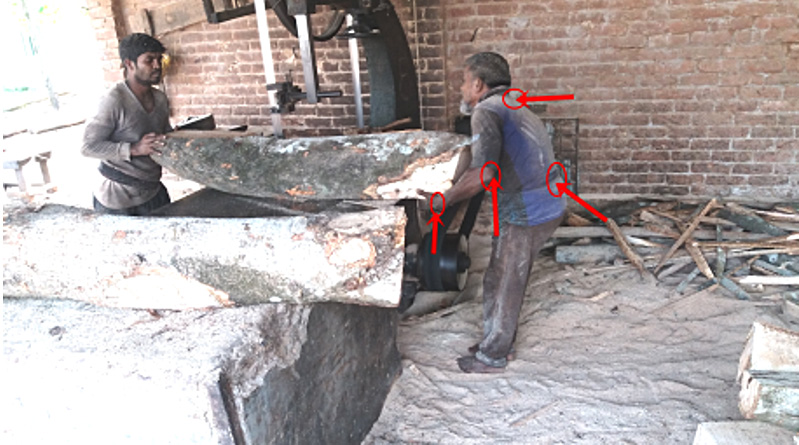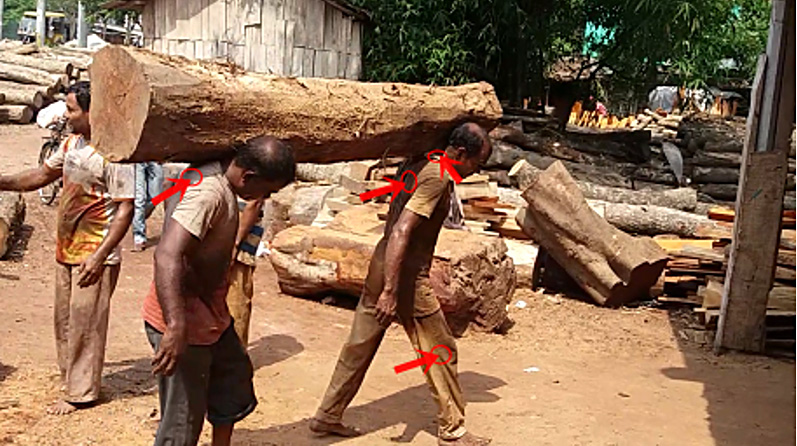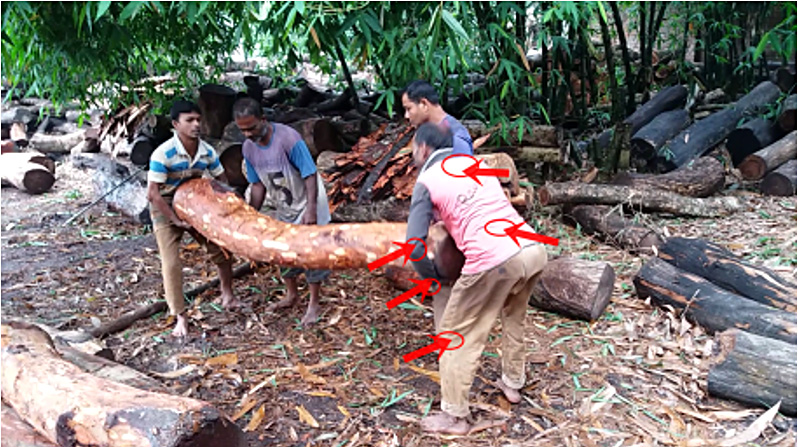Work - Related Musculoskeletal Disorders: A Case Study of Sawmill Workers in Bangladesh
Corresponding author Email: sumon.just16@gmail.com
DOI: http://dx.doi.org/10.12944/CWE.14.2.18
Sawmill workers in Bangladesh are increasingly at risk of emerging work-related musculoskeletal disorders (WRMSDs). Their jobs involve awkward manual handling tasks such as lifting, carrying, pushing and pulling. These are identified as risk factors for musculoskeletal disorders. The aims of this study are to find out the prevalence of musculoskeletal disorders and assessing the postural risk level among sawmills workers. This cross-sectional study was conducted with 254 workers from 60 sawmills at the southern part of Bangladesh. The overall 70.1% of sawmills workers were suffering musculoskeletal disorders in at least one body part for the last one year. The average Rapid Entire Body Assessment (REBA) score of four main tasks (Pushing, Pulling, Lifting, and Carrying the timber) was 9.25, which is high risk for MSDs symptoms. The main reasons behind these MSDs are lack of knowledge about workplace safety, working postures and the settings of the workplace. We have recommended to the management to apply the NIOSH (National Institute for Occupational Safety and Health) lifting and Manual Material handling techniques; arrange OSHA (Occupational Safety and Health Administration) ergonomic training to the workers. Also, suggested designing the working table and workplaces in ergonomically to mitigate the musculoskeletal disorders.
Copy the following to cite this article:
Rahman M. S, Khan A. H, Rahman M. S, Biswas B. Work - Related Musculoskeletal Disorders: A Case Study of Sawmill Workers in Bangladesh. Curr World Environ 2019; 14(2). DOI:http://dx.doi.org/10.12944/CWE.14.2.18
Copy the following to cite this URL:
Rahman M. S, Khan A. H, Rahman M. S, Biswas B. Work - Related Musculoskeletal Disorders: A Case Study of Sawmill Workers in Bangladesh. Curr World Environ 2019; 14(2). Available from: https://bit.ly/32gcN66
Download article (pdf)
Citation Manager
Publish History
Select type of program for download
| Endnote EndNote format (Mac & Win) | |
| Reference Manager Ris format (Win only) | |
| Procite Ris format (Win only) | |
| Medlars Format | |
| RefWorks Format RefWorks format (Mac & Win) | |
| BibTex Format BibTex format (Mac & Win) |
Article Publishing History
| Received: | 25-06-2019 |
|---|---|
| Accepted: | 27-08-2019 |
| Reviewed by: | 
 Dr. Gaurav Dhawan
Dr. Gaurav Dhawan
|
| Second Review by: |

 Dr. Madhu Gopal
Dr. Madhu Gopal
|
| Final Approval by: | Dr. Gopal Krishan |
Introduction
Musculoskeletal Disorders (MSDs) are known as injuries and disorders that affect the human body’s movement or musculoskeletal system. It includes some body parts such as muscles, tendons, ligaments, nerves, discs, blood vessels, etc. On the other hand, Work Related-Musculoskeletal Disorder (WRMSDs) have been caused by the continuous and long-term high repetitive task, sudden exposure to lifting or carrying of heavy loads, excessive force, working in an awkward body posture and vibration.1 Work-related musculoskeletal disorders affect both employers and workers. It increases absenteeism, employee turnover, recruitment and training cost, etc. and decreases productivity for the employer. WRMSDs also reduce the workers' quality of life by the job, economic and family stresses. It may also increase the direct and indirect cost as diagnosis and treatment for the workers.2
Musculoskeletal Disorders (MSDs) is one of the greatest occupational health problems among manual sawmill workers.3 The most activities of the sawmills in Bangladesh are controlled manually. These activities include lifting, carrying, pulling, pushing, etc. All of these activities belong to high-risk groups for Musculoskeletal Disorders (MSD) or injuries in different body parts of the sawmill workers.4 Some of the studies have been conducted to understand the prevalence of WRMSD among workers are as follows.
An observation was conducted with 110 male workers from a sawmill factory in Nimtala at Kolkata, India. Researchers were found that musculoskeletal discomfort was a major problem among the sawmill workers, primarily involving the lower back (100%), neck (95.96%), wrist (87.78%), and shoulder (84.44%) pain.3 They also identify the causative factors behind the improvement of such discomfort. A structured discussion using a modified-Standardized Nordic Questionnaire was conducted on 116 pre-cast construction workers (male) in sipitang, sabah, Malysia to determine the prevalence of Musculoskeletal Disorders (MSDs).5 Researchers showed that 80.17% of workers complained of experiencing ache, pain or body discomfort during and after work. They also found that, the high percentage of MSDs prevalence affecting the wrist (78.5%), shoulder (73.1%), and lower leg (71.0%) pain regions of the body.
Researchers6 used REBA to analysis the posture of sawmills workers in Karnataka state, India. REBA is postural analysis method used for assessing the risks level of work-related musculoskeletal disorders. To assign a score, following body parts such as wrists, forearms, elbows, shoulders, neck, trunk, back, legs and knees have used in the REBA score assessment sheet (Figure 1). Then the data have collected for each area and scored. Every single score signifies the level of MSD risk (Table 1).
Researchers6 observed the average REBA score was 7.5. This indicates that the workers were working above the safe limit. They also found the various conditions such as, hard environmental conditions (low temperatures, slippery and uneven ground); heavy works (manual handling of loads back flexed and twisted) dangerous tools and machinery such as chainsaws that expose workers to MSD risks.
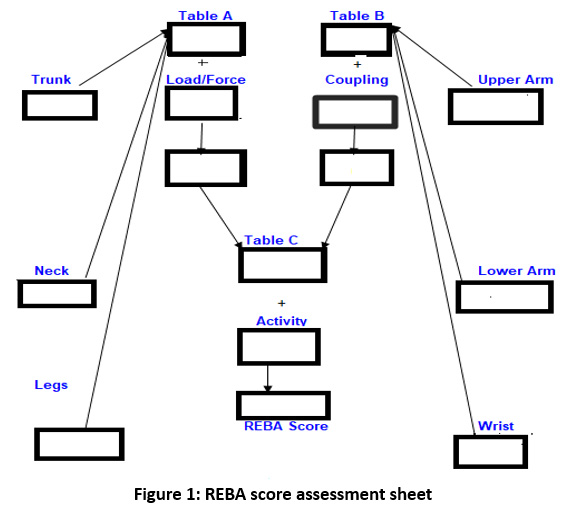 |
Figure 1: REBA score assessment sheet Click here to view Figure |
A large number of sawmill workers are suffered from Work-Related Musculoskeletal Disorders (WRMSDs) (3). They also spend a huge amount of money for medication purpose. However, we are not aware of any research work, which related to work-related musculoskeletal disorder among the sawmill workers in Bangladesh.
Therefore, the aims of this study are twofold. Firstly, to find the prevalence of musculoskeletal disorders and the risk level among the sawmill workers. Secondly, to identify the associated risk factors with musculoskeletal disorders symptoms among the sawmill workers in Bangladesh.
Methodology
Sample Collection
To conduct this cross-sectional study, 254 male sawmill workers were randomly selected from 60 sawmills in Jashore, Bangladesh. The selected respondent’s workers divided into four main type’s e.g; job activities. That includes lifting, carrying, pulling and pushing the timber.
Data retriever through structures questionnaire
In this study, face-to-face interview on wood sawmills workers (male) was taken using a Modified-Standardized Nordic Questionnaire (MNDQ)7 and a structured questionnaire. The questionnaire had three sections including socio-demographic information, criticisms of musculoskeletal disorders and physical risk factors. The questionnaires were two categories as an open-end and yes/no. A photo of body map delivered for easy identification of the affected body part. The photo of the body map is a sketch of the human body which indicating the nine body parts. A standard height-weight measurement scale (Electronic Body Scale TCS-200RT) used to measure the height and weight of the workers. Questioned were asked to participants if they had any musculoskeletal problems in the last 12 months. If the participant answered positively then further asked to identify the affected area or areas of the body. The participant also asked to identify the physical factors (postural, environmental and ergonomic) that affected the musculoskeletal systems. It took about 15-20 minutes to complete the questionnaire. We collected the data during day work hour (8 am to 6 pm).
Analysis of Posture
Work in natural posture is one of the main ergonomics principles. Obstinate working postures have considered as risk factors for work-related musculoskeletal disorders. It leads to fatigue, injuries, and stress on musculoskeletal systems. A video was taken to analysis the body movement and different working posture of sawmill workers. Snapshots of critical body posture have taken from the video that used in analyzing. The Rapid Entire Body Assessment (REBA)8 is an ergonomic tool. This tool used to assess the risk level of various body postures. The REBA scores with risk level have shown in
Table-1.
Table 1: REBA score and associated risk level
|
REBA Score |
Risk Level |
Action |
|
1 |
Negligible |
None necessary |
|
2 - 3 |
Low |
May be necessary |
|
4 - 7 |
Medium |
Necessary |
|
8 - 10 |
High |
Necessary soon |
|
11 - 15 |
Very High |
Necessary now |
Statistical Analysis
Descriptive analysis of socio-demographic information has performed as maximum, minimum, mean and standard deviation for continuous variables. Frequencies and percentages were derived as categorical variables. To find out the various risk factors and musculoskeletal discomforts, chi-square (x2) test has performed. All analyses have performed through SPSS (Statistical Package for the Social Sciences) version 21. The level of significance was considered as 5%.
Results and Discussions
The general physical information of 254 workers (sawmills) has shown in Table-2. The mean age of the workers is 37.37 years (SD = 13.71). There are no workers less than 18 years.
Table 2: General physical information of the workers (N=254)
|
Factors |
Minimum |
Maximum |
Mean |
SD |
|
Age (Years) |
18 |
72 |
37.35 |
±13.71 |
|
Working time (Hours) |
8 |
15 |
11.00 |
±1.94 |
|
Work Experience (Years) |
1 |
50 |
13.98 |
±11.36 |
|
Weight (kg) |
41 |
90 |
57.86 |
±8.60 |
|
Height (meters) |
1.5 |
1.8 |
1.62 |
±0.05 |
|
Body Mass Index (kg/m2) |
16 |
33 |
21.93 |
±2.70 |
The mean working time is 11 hours which very high from standard working hours. As said by the International Labour Organization (ILO), the standard working hours are 8 hours per day.9 High working hour’s leads to numerous problems among the workers include stress, health risks, lack of attentiveness, etc.10 The mean body mass index is 21.93 kg/m2 (SD=2.70) which indicates maximum workers are in normal ranges. A BMI of 18.5-24.9 indicates a healthy weight with respect to height.11 The healthy weight aids to lessen the risk of serious health-related problems and it pointers the persons close to his fitness goals.12 From these aspects, we found that maximum workers in this study are close to the fitness goal.
The socio-demographic information of the respondents has shown in Table-3. From the results, it can be found that about half (42.5%) are illiterate. Only 13% are received education up to secondary education. Almost (78.3%) workers are the smoker.
Table 3: Socio-demographic information of the workers (N=254)
|
Back ground Factors |
Frequency |
Percent |
|
|
Age range (Years) |
18-28 |
80 |
31.5% |
|
29-38 |
68 |
26.8% |
|
|
39-48 |
55 |
21.7% |
|
|
49-58 |
26 |
10.2% |
|
|
59-72 |
25 |
9.8% |
|
|
Education Level |
No education |
108 |
42.5% |
|
= |
113 |
44.5% |
|
|
=>Secondary |
33 |
13.0% |
|
|
Smoker or Non-smoker |
Non-smoker |
55 |
21.7% |
|
Smoker |
199 |
78.3% |
|
|
BMI Range |
<18.5 |
22 |
8.6% |
|
18.5-24.9 |
198 |
78.0% |
|
|
25-29.9 |
32 |
12.6% |
|
|
>=30 |
2 |
.8% |
|
|
Marital Status |
Married |
218 |
85.8% |
|
Unmarried |
36 |
14.2% |
|
|
Working time (hours) |
=>8 |
31 |
12.2% |
|
9-11 |
117 |
46.1% |
|
|
=>12 |
106 |
41.7% |
|
|
Work experiences (Years) |
1-10 |
123 |
48.4% |
|
11-20 |
68 |
26.8% |
|
|
21-30 |
42 |
16.6% |
|
|
31-40 |
13 |
5.1% |
|
|
41-50 |
8 |
3.1% |
|
The results of musculoskeletal symptoms from respondents have shown in Figure-2. Figure-2 indicates that 70.1% of sawmills workers had been suffered from musculoskeletal disorders in at least one region in the body over the previous 12 months. Researchers have found similar results in several studies.13, 14, 3 Among of all body parts, 70.1% suffered shoulder pain. Baba et al.,15 reported that 28.3% of construction workers suffering at shoulder pain in Malaysia. Results show that 62.2% of sawmill workers in Bangladesh are suffering from upper back pain. Researchers16 found 33% of automobile workers are suffering upper back pain in Bangladesh. In this study, the lowest musculoskeletal symptom of sawmill workers in Bangladesh is 45.7% for the wrist. Anas et al.,17 showed that 77% of worker of the Indian sawmill are facing wrist pain. Therefore, the average musculoskeletal symptoms among sawmill workers in Bangladesh are 55.41% which is very high. Therefore, we need to take the necessary steps to overcome these problems.
 |
Figure 2: Musculoskeletal disorders in various body regions Click here to view Figure |
The table 4 shows the relations between socio-demographic factors and reported musculoskeletal disorders of the sawmill workers in Bangladesh. Here, the work experience is statistically significant (P=0.034*) with musculoskeletal disorders. A report (18) showed that, high work experiences (P= 0.001*) that distress the musculoskeletal systems among male construction workers in Nigeria. On the other hand, other factors (age, weight, working time, smoking habit, marital status, education level) are statistically insignificant with musculoskeletal disorders.
Table 4: Relationship between socio-demographic factors and reported musculoskeletal disorders of the workers (N=254)
|
Socio-demographic factors(N=254) |
Respondent Musculoskeletal Disorders (%) |
Chi-Square value |
P-value* |
||
|
Yes |
No |
||||
|
Age (Years) |
18-28 |
49(27.7%) |
31(40.3%) |
6.161 |
.187 |
|
29-38 |
47(26.6%) |
21(27.3%) |
|||
|
39-48 |
40(22.6%) |
15(19.5%) |
|||
|
49-58 |
22(12.4%) |
4(5.2%) |
|||
|
59-72 |
19(10.7%) |
6(7.8%) |
|||
|
Work experience (Years) |
1-10 |
75(42.4%) |
48(62.3%) |
10.430 |
0.034* |
|
11-20 |
50(28.2%) |
18(23.4%) |
|||
|
21-30 |
36(20.3%) |
6(7.8%) |
|||
|
31-40 |
10(5.6%) |
3(3.9%) |
|||
|
41-50 |
6(3.4%) |
2(2.6%) |
|||
|
Weight (kg) |
<=50 |
38(21.5%) |
12(15.6%) |
9.071 |
0.059 |
|
51-60 |
78(44.1%) |
47(61.0%) |
|||
|
61-70 |
50(28.2%) |
11(14.3%) |
|||
|
71-80 |
8(4.5%) |
5(6.5%) |
|||
|
>=90 |
3(1.7%) |
2(2.6%) |
|||
|
Working time (hours) |
>8 |
20(11.3%) |
11(14.3%) |
1.034 |
0.596 |
|
9-11 |
85(48.0%) |
32(41.6%) |
|||
|
>12 |
72(40.7%) |
34(44.2%) |
|||
|
Smoking habit |
Non-smoker |
35(19.8%) |
20(26.0%) |
1.216 |
0.270 |
|
Smoker |
142(80.2%) |
57(74.0%) |
|||
|
Marital status |
Married |
156(88.1%) |
62(80.5%) |
2.559 |
0.110 |
|
Unmarried |
21(11.9%) |
15(19.5%) |
|||
|
Education level |
No education |
79(44.6%) |
29(37.7%) |
2.907 |
0.234 |
|
<=Primary |
79(44.6%) |
34(44.2%) |
|||
|
|
>=Secondary |
19(10.8%) |
14(18.1%) |
||
Figure 3 shows the various risk factors that affect musculoskeletal disorders among workers. Here, air temperature, noise from the machine, dust, and safety aids, heavy workload, as well as repeated task have considered as environmental factors. On the other hand, lifting, carrying, pulling and pushing to timber have considered as task factors. Although there is various task exist in a sawmill but in this study, we considered the only four-mentioned task. Figure-3 shows 70.1% of workers blamed that noise from the sawmill is so high. This high-leveled noise is responsible to damage the auditory nerve of the ears. As a result, most of the workers suffer a hearing problem. According to the definition of MSDs, noise allied problem is related to MSDs. Other factors associated with the sawmill environment included air temperature (40.2%), dust (57.5%), safety aides (58.3%), heavy workload (55.1%) and repeated task (66.5%). Researchers19 observed similar results among Nigerian sawmill workers. Include as temperature (41.5%), noise (81.9%), dust (95.7%) and safety aides (59.6%). Indonesian farmers (48.6%) responded heavy workload lead to musculoskeletal disorders (20). The prevalence of musculoskeletal symptoms was reported (56.1% of men and 50% of women), for the repeated task conducted by Anamai et al.,21
 |
Figure 3: Factors affecting the musculoskeletal disorders. Click here to view Figure |
In this study, workers also respondent about task factors those are responsible for musculoskeletal disorders. Include as lifting timber (62.2%), carrying timber (49.2%), pulling timber (52%) and pushing timber (55.9%). Researchers22 carried out a study among workers of Iranian casting workshops and found similar outcomes. They showed that handling material in lifting (86%), carrying (66%), pulling task (48%), pushing (43%) occurred in the high rate of work-related musculoskeletal disorders among the workers. They concluded the ergonomics inventions and redesigning manual material handling task could reduce work-related musculoskeletal disorders. The Rapid Entire Body Assessment (REBA) score, risk level and relative action for four tasks such as pushing, pulling, lifting and carrying have shown in Table 5.
Table 5: Rapid Entire Body Assessment (REBA) score
|
Task |
REBA Score |
Risk Level |
Action |
|
Pushing |
9 |
High |
Necessary soon |
|
Pulling |
7 |
Medium |
Necessary |
|
Lifting |
11 |
Very High |
Necessary now |
|
Carrying |
10 |
High |
Necessary soon |
|
Average |
9.25 |
High |
Necessary soon |
Table 5 represents the average REBA score is 9.25. This is in a high-risk zone and we need to take necessary action soon. Among four tasks, the maximum REBA score obtains for lifting task. It risks level is very high and should take action as now. The lowest score is 7 for pulling task. Others are pushing (9) and carrying (10) as in the high-risk zone. Researchers23 also revealed that the high-risk level among sawmill workers is in India. They found that the REBA scores for lifting, carrying, pulling and pushing the timber were 11, 9, 10 and 11 respectively.
Table 6: Work-related musculoskeletal disorders by tasks
|
Tasks |
Problematic work-related activities |
Risk Factors |
MSDs for body regions |
Figure |
|
Pushing the timber into saw table. |
Bending of the body and trending the body parts |
Awkward posture, Repetition and Force |
Lower back, Elbow and Wrist disorders |
|
|
Pulling the timber from saw table. |
Bending of the body, hand and legs |
Force, Awkward posture and Repetition |
Lower back, Upper back, Elbow and Wrist disorders |
|
|
Carry out the timber to saw table. |
Bending the hand, legs and twisting the body |
Awkward posture |
Upper back, neck, shoulder and leg region disorders |
|
|
Lifting the timber from ground. |
Back bending and twisting the body |
Awkward Posture, Force |
Upper back, lower back, arm, wrist and leg region disorders |
Based on Table 6, the activities of sawmill mainly involve lifting, carrying, pulling and pushing the timber to get the raw wood for furniture. Ergonomics risk factors mainly correlated to the musculoskeletal disorders can be realized from each activity or task of sawmill. These tasks involve a stubborn posture, excessive force and repetitive works to the sawmill workers. Prolong continuing these activities cause damage to the muscular systems of the body. These systems involve the neck, shoulders, upper back, lower back, elbow, wrist, knee, etc. Researchers24 revealed the wrong working posture that is generally associated with the development of musculoskeletal discomfort. Thus, when workers work in uncomfortable posture for a long time, they suffer from musculoskeletal discomfort. Researchers25 also presented that the obdurate working posture can cause strains in the low back of the workers and fall negative impact on their health. They work according to job demands and work more time to earn more. This recommended for their long working hours, with uniformity of the work.
Conclusions
This study concludes that most of the sawmill workers in Bangladesh are affected by the musculoskeletal disorders. The prevalence of overall musculoskeletal disorders is 70.1%. We revealed the main reason behind these MSDs is lack of ergonomics related knowledge. Besides, they are working in such an environment, which is not at all good for health. Another reason is incorrect working positions. The average REBA is 9.25 that show the tasks are performing in high-risk level. Therefore, it is early needed to redesign the workstation in ergonomically. In this study, we also found some risk factors that lead to musculoskeletal injuries. Among these, noise (70.1% reported) from the saw machine is very high. Therefore, both management and workers should work together to eliminate or reduce these problems. The worker should use safety aids in a regular manner. Technical training must be needed of the workers on the knowledge of ergonomic safety, risk factors, and working positions. The workplace should be well ordered and clean. Mechanical handling aids are required as much as possible. Management should provide a sliding table for easy movement of the timber on the working table.
Limitations and Future Scope
There are some potential limitations behind this cross-sectional study. These include as the study have been conducted only in the Jashore region of Bangladesh. The intensity of MSDs, duration and medical history were not considered. The study will expand in the future considering the variables to find the more precision outcomes.
Acknowledgements
We would like thanks to all sawmill workers, who helped in collecting data.
Funding
Authors of this research work had provided all financial support. There is no other source of fund.
Conflicts of Interest
The authors declare no conflict of interest.
Ethical Review
The study has not reviewed and approved by an Institutional Ethics Committee or Institutional Review Board. However, other ethical issues as plagiarism, data duplications, double publications, etc. have been strongly observed by the authors.
References
- NIOSH. Musculoskeletal Health Program. https:// www.cdc.gov/niosh/programs/msd/default.html, December 6, 208. (Accessed on 20 April 2019).
- Poursadeghiyan M, Khammar A, Hami M, Darsnj A, Moradi H.Y.M. REBA method for the ergonomic risk assessment of auto mechanics postural stress caused by working conditions in Kermanshah (Iran). Ann Trop Med Public Health. 017; 10: p. 589-94.
- Ghosh S, Barma S, Dev S, Gangopadhyay S, Chandra A.M. An Ergonomic Study on Musculoskeletal Health Hazards Among Sawmill Workers of West Bengal, India. J. Hum. Ergol. 2011; 40: p. 1-10.
- Edwin M and Tappin B.T.D. Musculoskeletal Disorders in Sawmilling: Ergonomics Work System Assessments and Suggested Interventions. Center for Human factors and Ergonomics (COHFE), 2003.
- Shamsudin.S.B, Lukman.K.A, Muktar M.S.J.M.Z. Assessment of ergonomic risk level and working performance of pre-cast construction workers in sabah. Malaysian Journal of Public Health Medicine. 2017; 17(2): p. 11-158.
- Qutubuddin S.M, Hebbal S.S, Kumar A .C.S, Ali A. An Ergonomic Study of Work Related Musculoskeletal Disorders Among The Workers Working in Typical Indian Saw Mills. International Journal of Engineering Research and Development. 2012 September; 3(9): p. 38-45.
- Kilbom A, Vinterberg H, Biering-Sorensen F, Andersson G, Kuorinka G.J.K.I, Jonsson B Standardized Nordic Questionnaires for The Analysis of Musculoskeletal. Appl Ergon. 198; 18: p. 233–237.
CrossRef - Hignet and Atamney M.C. Technical note: Rapid Entire Body Assessment (REBA). Applied Ergonomics. 2000; 31: p. 201-205.
CrossRef - International Labour Standards on working time. https://www.ilo.org>lang--en (Accessed on 18 August 201
- Effects of overtime. https://en.m.wikipedia.org/wiki/Effects_of_overtime. (Accessed on 18 August 2019)
- Braziar.Y. Measuring BMI for adults, children, and teens.https//www.medicalnewstoday.com/articles/323622.php, November 8, 2018. (Accessed on 18 August 2019)
- Understanding Your Body Mass Index. https://www.active.com/fitness/calculators/bmi. (Accessed on 18 August 2019)
- Das S.K, Pathak V, Chakraborty S.T. Occupational Stress, Musculoskeletal Disorders and other Factors Affecting The Quality of Life in Indian Construction Workers. International Journal of Construction Management. 2017 May;: p. 1-7.
- Alghadir A, and Anwer S, Prevalence of Musculoskeletal Pain in Construction Workers in Saudi Arabia. The Scientific World Journal. 2015;: p. 5 pages.
CrossRef - Daruis D.D.I, Khamis N.K, Mohamad D, Daud S.F.M., Amdan S.M, Aziz R.A, Deros N.J. B.M. Prevalence of Work Related Musculoskeletal Disorders Symptoms among Construction Workers: a Case Study in Malaysia. Iranian J Publ Health. 2014; 43(03): p. 53-57.
- Rahman M.M, Mandal S, Akter N.N.S. Musculoskeletal Symptoms and Physical Risk Factors Among Automobile Mechanics In Dhaka, Bangladesh. South East Asia Journal of Public Health. 20; 6(1): p. 8-13.
CrossRef - Qutubuddin S.M, Hebbal S.S, Kumar A .C.S, Ali A. An Ergonomic Study of Work Related Musculoskeletal Disorders Among The Workers Working in Typical Indian Saw Mills. International Journal of Engineering Research and Development. 2012 September; 3(9): p. 38-45.
- Ekpenyong C.E, Inyang U.C, Associations Between Worker Characteristics, Workplace Factors, and Work-Related Musculoskeletal Disorders: A Cross-Sectional Study of Male Construction Workers in Nigeria. International Journal of Occupational Safety and Ergonomics(JOSE). 2014; 20(3): p. 447–462.
CrossRef - Ogunfowokan A.A, Mbada C, Olatubi M.I, Ogungbemi A.V, Faremi F.A. Occupational Hazard Awareness and Safety Practices Among Nigerian Sawmill Workers. International Journal of Medical Science and Public Health. 2014; 3(10): p. 1244-1248.
CrossRef - Purwandari R, Wuryaningsih E.W, Susanto T. Prevalence and Associated Factors of Health Problems Among Indonesian Farmers. Chinese Nursing Research. 17; 4: p. 31-37.
CrossRef - Meepradit P, Sa-ngiamsak T, Thetkathuek, A. A Cross-sectional Study of Musculoskeletal Symptoms and Risk Factors in Cambodian Fruit Farm Workers in Eastern Region, Thailand. Safety and Health at Work. 2018; 9: p. 192-202.
CrossRef - Motamedzade M, Faghih M.A, Mohraz M.H, Mohammadi S.M.H. Manual Material Handling Assessment Among Workers of Iranian Casting Workshops. International Journal of Occupational Safety and Ergonomics (JOSE). 2013; 19(4): p. 675–681.
CrossRef - Ghosh S, Barma S, Dev S, Gangopadhyay S, Chandra A.M. An Ergonomic Study on Musculoskeletal Health Hazards Among Sawmill Workers of West Bengal, India. J. Hum. Ergol. 2011; 40: p. 1-10.
- Mattila M, Kivi P, Analysis And Improvement of Work Postures in The Building Industry: Application of The Computerised OWAS Method. Appl. Ergon. 1991; 22: p. 43-48.
CrossRef - Kaul E.I.U, Nwuba R.N. The effect of working posture on the Nigerian hoe farmers. J. Agri. Engi. Research. 1986; 33: p. 179-185.
CrossRef


